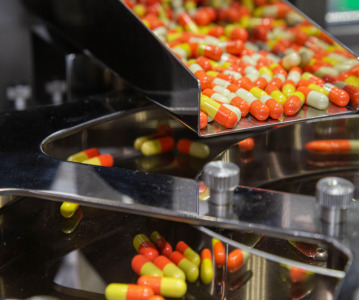CPHI Report Warns Industry Must Actively Drive Process Improvemen?ts itself to Meet Growing Global Demand
CPHI Worldwide, part of UBM Live’s Pharmaceutical Portfolio, announce the findings of its Pharma Insights report on Manufacturing. Overall the report indicates that the industry is aware of the need to continue to improve manufacturing practices, processes and efficiencies to dive down costs and improve profits and drug quality. However, the report warns that industry must more actively take the lead if we are to see these vital changes driven through- currently, the inertia of the existing model is impeding innovation and preventing wide spread adoption.
CPHI adds that most of the sector now states it is utilising continuous process improvements to drive efficiency savings, but more could be done to revolutionise practices. CPHI findings show that 26% are using ‘statistical process control’, 21% using ‘process capability analysis’, 16% QbD, 12% ‘six sigma’ and 11% using both ‘lean/kaizen’ and ‘PAT’. Furthermore, many are building for the future and making essential upgrades to existing equipment with 70% actively investing in manufacturing.In the medium to long term, we should see a cross-pollination of process improvements from generics (where costs savings can still be made) though CMOs and ultimately into Big Pharma’s patented products. The advantage here is that lower cost patented products would open huge new markets, whilst reducing the attractiveness of counterfeits.
For cost savings to be made however, the report clearly states further improvements must come from the industry itself and not the regulator, as this will only increase costs.
CPHI panel member and President of EPCOT International Girish Malhotra, added: “not much will change in the current processes as the needed regulatory approval will come in the way of any improvement of existing processes. Success to exceed regulations will only come from process inception stage along with command of the process as they become commercial. ‘Process centricity’ has to overtake the current ‘regulation centricity’ if pharma wants to see cost reductions in new and existing processes.
”In terms of the industry’s economic strength, the findings show the sector is in good health with 59% planning to increase headcount this year and only 4% planning reductions. In outsourcing we continue to see increases with 41% outsourcing more of their manufacturing. Going forwards, if manufacturers want to improve product quality, they must find a supplier that aligns with their own GMP compliance expectation. Additionally, nearly 50% of the industry stated they introduced more than three products last year, with a further 41% adding 1–3 products.
The biggest manufacturing goals are to ‘increase efficiencies’ and ‘safety’ and already 89% are testing raw material sourced- with ‘compendial testing’ by far the most favoured method (81%).
“With the majority of the industry now committed to process improvements and increased product quality the next few years will hopefully see more new manufacturing methods coming to market, with tighter process controls — these should ultimately reduce costs and increase profits for the industry.” Chris Kilbee, Group Director Pharma.
CPHI believes we may be at the cusp of a revolution and if one major pharma company starts reaping the benefits of implementing process perfection from initial development to commercialisation others will follow. Drawing all these findings together the report concludes that the industry has made great strides and with new efficient techniques drugs should be more available globally at reduced cost, enabling developing countries increased access.
Chris Kilbee added: “The desire to modernise processes across the industry is clearly there and taking a long term view we can see that the way we conduct development work right through to commercialisation has the chance to revolutionise the business model. Patented products will be opened up to a wider number of the globe’s seven billion inhabitants, which is a real human goal, but also one that will see the industry become more sustainable and increase profits. I believe that with these commitments we see a situation where industry actively drives improvements and takes these new methods to the regulator- cost savings and improved quality should go hand in hand”.
Related News
-
News Pharmapack Awards 2024 Patient-Centric Design Award Winner – Dr Ferrer BioPharma
The 2024 Pharmapack Awards celebrated the best in innovation and design for the pharmaceutical packaging and drug delivery industry on January 24, 2024. -
News Women in Pharma: Minding the Gap at Pharmapack 2024
2024 marks the first year Pharmapack will host a Diversity track dedicated to bridging the gap within the pharmaceutical packaging and drug delivery sector. The track includes a panel discussion on 'Enabling Diversity in the Workplace,' focused... -
News Pharmapack Awards 2024 - Celebrating Packaging and Drug Delivery Innovation
The 2024 Pharmapack Innovation Awards ceremony celebrated the best in pharmaceutical packaging and drug delivery innovation at all levels. The awards were held on January 24, 2024 at the Paris Expo Porte de Versailles. -
News 2024 Pharma Industry Trends Outlook: Collaboration, Market Maturity, and Digital Futures
The annual CPHI Online 2024 Pharma Trends Outlook, in partnership with Arvato Systems, identifies 12 key industry trends shaping the life sciences industry in the coming year. -
News New Novo Nordisk AI hub for drug discovery to open in London, UK
Danish pharmaceutical giant Novo Nordisk will be opening an AI-based research facility in the heart of London to advance drug discovery operations. -
News BioNTech to begin mRNA vaccine manufacturing in Rwanda by 2025
German biotechnology company BioNTech has stated their intentions to begin production at their mRNA vaccine factory in Rwanda by 2025, which will mark the first foreign mRNA vaccine manufacturing site on the continent of Africa. -
News Women in Pharma: Looking back on 2023 and moving forward to 2024
In this monthly series, we interview women from across the pharmaceutical industry and supply chain to discuss the importance of gender diversity in healthcare, the workplace, and beyond. -
News CPHI Barcelona 2023: Partnering for Success – Managing Outsourcing Relationships to Optimise Manufacturing Operations
During CPHI Barcelona 2023, insightful content sessions offered attendees the chance to explore trending topics with expert speakers and panellists. Here, we summarise what the pharma industry and supply chain are talking about the most.
Position your company at the heart of the global Pharma industry with a CPHI Online membership
-
Your products and solutions visible to thousands of visitors within the largest Pharma marketplace
-
Generate high-quality, engaged leads for your business, all year round
-
Promote your business as the industry’s thought-leader by hosting your reports, brochures and videos within your profile
-
Your company’s profile boosted at all participating CPHI events
-
An easy-to-use platform with a detailed dashboard showing your leads and performance







